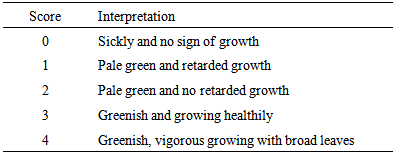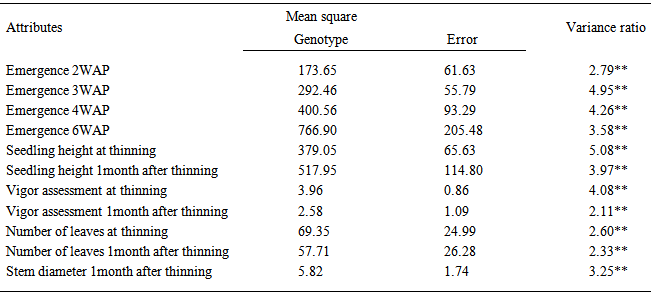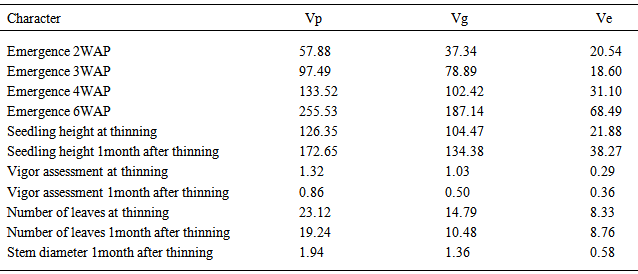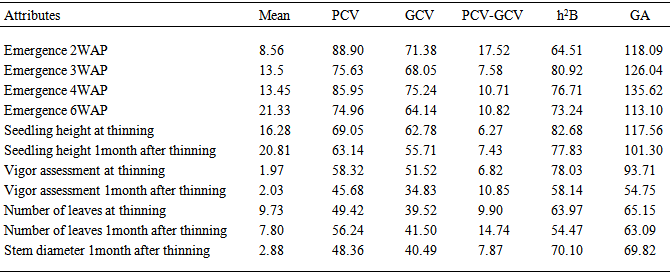-
Paper Information
- Previous Paper
- Paper Submission
-
Journal Information
- About This Journal
- Editorial Board
- Current Issue
- Archive
- Author Guidelines
- Contact Us
International Journal of Plant Research
p-ISSN: 2163-2596 e-ISSN: 2163-260X
2015; 5(3): 68-72
doi:10.5923/j.plant.20150503.04
Influence of Growth Media on Seedling Emergence and Early Growth of Five Pawpaw (Carica papaya L.) Morphotypes
Nwofia G. E., Okwu Q. U.
Department of Agronomy, Michael Okpara University of Agriculture, Umudike
Correspondence to: Nwofia G. E., Department of Agronomy, Michael Okpara University of Agriculture, Umudike.
| Email: |  |
Copyright © 2015 Scientific & Academic Publishing. All Rights Reserved.
Five ‘Sunrise Solo’ cultivars of Pawpaw Carica papaya morphotypes were selected based on fruit shape and pulp color and their seeds sown in three different media namely Saw dust, rice husk, and top soil at the green house of the Michael Okpara University of Agriculture, Umudike, Nigeria to determine their emergence percentage and seedling growth attributes. The experiment was set up as a factorial in completely randomized block design. Highly significant differences (P <0.01) was observed for seedling emergence and seedling growth attributes studied. The result showed that top soil is a better medium for pawpaw nursery when compared to rice husk and saw dust. Genetic component analysis showed that most of the traits had more genetic than non-genetic factors that contributed to the variability observed for most of the traits. This was further validated by some of the traits having high heritability in the broad sense and genetic advance indicating that selection cause effective at the seedling levels for such traits.
Keywords: Seedling emergence, Pawpaw morphotypes, Media, Heritability, Genetic advance
Cite this paper: Nwofia G. E., Okwu Q. U., Influence of Growth Media on Seedling Emergence and Early Growth of Five Pawpaw (Carica papaya L.) Morphotypes, International Journal of Plant Research, Vol. 5 No. 3, 2015, pp. 68-72. doi: 10.5923/j.plant.20150503.04.
1. Introduction
- Carica papaya (family Caricacaeae) is a tropical fruit grown widely in Nigeria for food, ornamentals and traditional health services [1]. It contains many biologically active components of which two important ones are: Chymopapain and papain which aids digestion [2].Carica papaya produce natural compounds (annonaceous actogenius) in leaf bark and twig tissues that have anti tumor and pesticidal properties [3]. The leaf tea or extract has a reputation as a tumor destroying agent [4]. The unique fruit is used as a remedy for ulcer and importance [5]. The papaya fruit also contains a milky juice in which the active principle known as papain is present. Aside its value as a remedy in dyspepsia and kindred ailments, it has been utilized for beer clarification and as a meat tenderizer [6].Tropical fruit crops and other plantation crops are traditionally established with seedlings previously grown in nursery which allows the establishment of seedlings under controlled environments. The growing condition of the nursery is under the control of the nursery-man, therefore seedling quality invariably is determined by the quality of cultural practices engaged by the nursery man, [7] reported that the quality of container grown ornamental plants is dependent on the physical and chemical compositions of the medium, the growing environment and plant management. Raising seedlings in nursery assures that orchards/ plantations are established with superior quality planting materials which have distinct advantages of better survival and growth.Pawpaw is mainly propagated by seeds and the seedlings are grown in the nursery before being transplanted to the field. Transplants are commonly used to establish commercial papaya to offset the loss of expensive certified seed and to avoid strong weed interference in the early stages of growth [8]. Seed germination of fruit crops is affected by factors such as substrate used, environmental factors like oxygen, temperature and light [9] cultivar, mineral nutrition and plant regulators [8] and plant management such as watering, pest and disease control [10]. Seed germination in Carica papaya is slow, erratic and incomplete [11]. The seeds are enclosed within a gelatinous sarcotesta which is formed from the outer integument [12]. It has been shown that the sarcotesta can prevent germination [13] but the removal of the sarcotesta does not break dormancy in pawpaw.Recent attempts to encourage farmers to cultivate pawpaw in plantations in South Eastern, Nigeria have not been very successful due to several production constraints. Among the constraints are lack of improved varieties, lack of improved propagation techniques, slow and erratic seed germination and growth of subsequent seedlings. Despite the fact that pawpaw is a useful fruit crop with a high potential income source, only limited efforts have been made to improve this crop. To achieve such improvement proper agronomic procedures needs to be developed, therefore the objective of this study was to determine the emergence and seedling growth characteristics of five morphotypes of Carica papaya using three growth media.
2. Materials and Methods
- This study was conducted in the green house of Michael Okpara University of Agriculture, Umudike between March and June 2011.Umudike is located at a longitude 07°34°E, latitude 05°29’N at an elevation of 122m above sea level.Planting Material and MediaFive pawpaw morphotypes were selected based on fruit shape and fruit pulp colour and used in this study. The morphotypes are round shaped with yellow pulp, pear shaped with red pulp, pear shaped red pulp, oblong shaped with yellow pulp and convex shaped with orange pulp and were planted in three different media namely: sawdust, rice husk and top soil. Each medium was mixed with poultry manure in the ratio of 2:1 and used to fill 2.5 L bucket. The experiment was a factorial in completely randomized design replicated three times. Factor A are the Carica papaya morphotypes and Factor B are the three media, that is, rice husk, sawdust and topsoil. Four seeds of each morphotype were planted in each bucket and six weeks after sowing, seedlings were thinned to one per bucket. Seedling emergence was taken at 2,3,4,5 and 6 weeks after planting while growth characters and seedling vigour were measured at thinning and one month after thinning. The data on seedling vigour were based in accordance with [10].
|
 where MSG, MSE and r are mean squares of genotypes, error and number of replicates respectively. The phenotypic (PCV) and genotypic (GCV) coefficients of variations were evaluated by the methods of [17-19] as follows:
where MSG, MSE and r are mean squares of genotypes, error and number of replicates respectively. The phenotypic (PCV) and genotypic (GCV) coefficients of variations were evaluated by the methods of [17-19] as follows: Where VP, VG and
Where VP, VG and  are phenotypic and genotypic variances and grand mean respectively for the traits under consideration. Broad sense heritability (h2B) was expressed as the percentage of the ratio of VG to VP was estimated on genotypic mean basis as described by [20]. Genetic advance was estimated by the method of [21] as GA = k(Sp) h2B where k is a constant (2.06 at 5% selection pressure), sp is the phenotypic standard deviation √VP, h2B is the broad sense heritability. GA was calculated as a percentage of the mean.
are phenotypic and genotypic variances and grand mean respectively for the traits under consideration. Broad sense heritability (h2B) was expressed as the percentage of the ratio of VG to VP was estimated on genotypic mean basis as described by [20]. Genetic advance was estimated by the method of [21] as GA = k(Sp) h2B where k is a constant (2.06 at 5% selection pressure), sp is the phenotypic standard deviation √VP, h2B is the broad sense heritability. GA was calculated as a percentage of the mean.3. Results and Discussion
- Highly significant difference (p<0.01) were observed in the emergence percentage and seedling growth attributes of the pawpaw morphotypes studied.The highest percent emergence was observed in morphotype 4 grown in topsoil at the second, third and fourth week after planting with the values 23.33%, 28.33% and 36.67% respectively. At the sixth week, an emergence percentage of 43.33% was observed in morphotypes 2 grown in topsoil. At thinning, the longest seedling was observed in morphotypes 4 grown in topsoil with a height of 35.28cm while at a month after thinning morphotypes 5 grown in topsoil had the highest record as regards seedling height which differed significantly from the morphotypes grown in other rooting media except for morphotypes 1 grown in saw dust. At and a month after thinning, the highest number of leaves were observed in morphotypes 2 grown in saw dust (17.24) and top soil (15.57) respectively. The data obtained for vigour assessment at and a month after thinning indicates that, morphotypes 4 grown in topsoil (3.53) and morphotypes 5 grown in top soil (3.33) respectively had the highest values and they differed significantly from morphotypes 1, 2, 3, 4, 5 grown in rice husk. The thickest stem diameter was recorded in morphotypes 2 grown in topsoil (4.52) and it differed significantly from morphotypes 1,2,3,4 and 5 grown in rice husk.The results obtained from table 2 indicate that morphotypes two and four grown in top soil did better than other morphotypes at emergence and early growth attributes. Topsoil performed slightly better than saw dust, but because saw dust is readily available and affordable, it is preferred. Also, the continuous collection of top soil for raising pawpaw seedlings may posse a constraint as it is bulky, heterogeneous in mineral composition and could cause soil erosion. Similar results were reported [22] and [23].Rice husk performed least relative to other substrates used as observed by the slow emergence and the seedling growth attributes evaluated. This could be due to the trace levels of nitrogen when compared with other growth media used. Similar results were reported by [24] and [23].Table 3 shows that the analysis of variance were highly significant for all the attributes (p<0.01). This suggests the possibility of improving the traits through genotypic selection. Table 4 partitions the result of the field experiment into phenotypic and genotypic components to show existing variation. The error variance was observed to be smaller than the genotypic variance for all the characters. This indicates that the genotypic component is the major contributor to the total variance for these characters, so the variability in the phenotype for the different characters has more genetic than non genetic basis. The variability due to genotypic variance indicates considerable scope for selection. Similar results have been reported by [25] for niger, [26] for sunflower, [27] for Vernonia galamensis, [28] for cowpea.The overall mean for each attribute, phenotypic and genotypic coefficients of variation, broad sense heritability estimates and expected genetic advance for emergence and seedling growth of pawpaw were shown in Table 5. The phenotypic coefficients of variation ranged from 45.68-88.90 and were higher than the corresponding genotypic coefficients of variation which had values from 34.83-75.23. High values for phenotypic and genotypic coefficients of variation were observed at two and four weeks after emergence, seedling height at thinning, vigour assessment at thinning and number of leaves at thinning. The phenotypic coefficient of variability (PCV) was generally higher than that of genotypic coefficient of variability for all characters and in many cases, the values differed widely. The difference between PCV and GCV suggests an interaction between the environment and the attributes such as emergence at two weeks, seedling height and vigour at thinning. Thus, selection of superior genotypes based on such characters would not be effective as reported by [29-32] in cowpea, [33] in Linseed, [12] in Sphenostylis stenocarpa, [27] for V. galamensis and [28] in cowpea.The attributes with high genotypic coefficients of variation also had high expected genetic advance which ranged from 54.75%-117.56%. Broad sense heritability estimates ranged from 58.14%-82.68% and were highest for seedling height at thinning, emergence of pawpaw at two weeks and vigour assessment at thinning. These high values indicate that environmental factors had little effect on phenotypic variance observed among attributes and as such, such characters can be relied upon as regards selection.Heritability and genetic advance for most of the traits were high indicating that selection can be efficient at the seedling for the improvement of these traits. Similar results were reported by [34] using Brassica species, [27] and [28].In conclusion, differences exist among morphotypes of the same variety of pawpaw as shown by the specific responses of the five morphotypes under study to different planting media. Early growth characters of the seedlings were considerably higher when grown under topsoil as compared to the other two media. Pawpaw breeders can therefore select improved and high yielding pawpaw seedlings for the establishment of plantations based on the differences in their emergence and early growth characters.
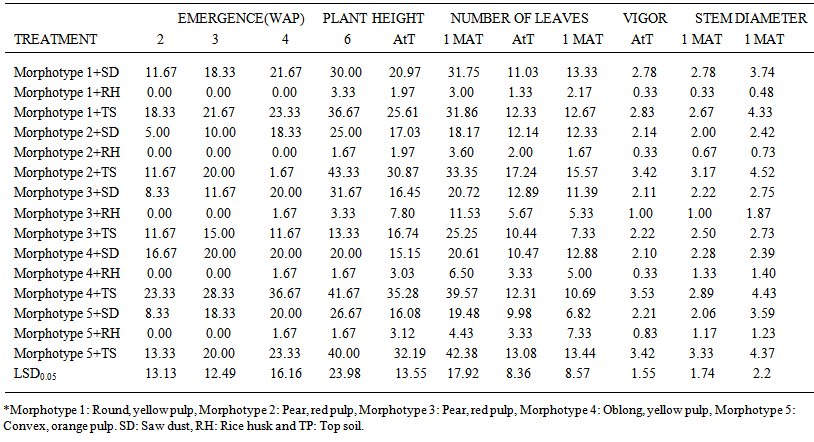 | Table 2. Emergence and seedling growth in five (5) pawpaw morphotypes germinated in sawdust, rice husk and topsoil |
|
|
References
| [1] | Sofoware, A; (1997). Medicinal plants used in Traditional Medicine in Africa. First Ed. John Wiley and Sons Chichester New York. Pp:128-129. |
| [2] | Brocklehurst, K. and E. Salih, 1985. Fresh non-fruit latex of Carica papaya contains papain, multiple forms of chymopapain A and papaya proteinase OMEGA. Biochem. J.,228(2): 525-527. |
| [3] | Mclanghlin, J.L., Ratanyake, S. Rupprecht, J. K and, Potter, W.M (1992). Evaluation of the various parts of the pawpaw trees, Asimina triloba (Annonaceae), as commercial source of the pesticidal annonaceous acetogenins. J. Econ. Entomol. 85: 2353-2356. |
| [4] | Walter Last (2008). Cancer remedies.www.health-science-spirit.com/cancer6-remedies. |
| [5] | Elizabeth, K., 1994. Immense Help from Natures Workshop. 1st Edn., Elikaf Health Services Ltd., Ikeja, Lagos pp: 207-209. |
| [6] | Bouanga-Kalou, G. Kimboguila, A. Nzikou, J.M., Ganongo P, F.B., Moutoula, F.E., Panyoo-AKDOWA, E., Siliou, T., and Desobry, S. (2011). Extraction and characteristics of oil seed from papaya (Carica papaya) in Congo Brazzaville. Asian Journal of Agricultural Sciences 3(2): 132-137. |
| [7] | Lamont G.P and O’Connell M.A., (1987). Shelf-life of bedding plants as influenced by potting media and hydrogels. Scientia Horticulturae, 31,141-149. |
| [8] | Morales-Payan, J.P and W.M Stall (2004). PAPAYA (Carica papaya) Transplant Growth is Affected by a Trichoderma- based Stimulator. Proc. Fla. State Hort. Soc 117:227-231. |
| [9] | Hartmman H.T, Kester, D.E, Davis, F.T, and Geneve R.L (2001). Plant propagation, principles and practices 7th Edition, Prentice Hall Publishers, New Jersey. |
| [10] | Baiyeri K.P., 2006. Seedling emergence and growth of pawpaw (Carica papaya) grown under different coloured shade polyethylene. Int. Agrophysics Journal.,20, 77-84 |
| [11] | Chacko, E.K. and Singh, R.N. (1966). The effect of gibberellic acid on papaya seeds and subsequent seedling growth. Tropical Agriculture, Trinidad, 43, 341-346. |
| [12] | Okoye F.I and Ene-Obong E.E (1992). Genetic variability and correlation studies in African yam bean (Spenostylis stenocarpa). Nigeria Journal of Botany 8:75-83. |
| [13] | Lange AH (1961) Factors affecting sex changes in the flowers of Carica papaya L. Journal of the American Society for Horticultural Science 77, 252-264. |
| [14] | SAS Institute (2001). SAS user’s guide, statistics. SAS Inst. Cany N C. |
| [15] | Wricke G. and Weber W.EE (1986). Quantitative Genetics and Selection in Plant Breeding. Berlin: Walter de Gruyter. |
| [16] | Prasad S.R, Prakash R, Sharma C.M and Haque M.F (1981). Genotypic and phenotypic variability in quantitative characters in oat. India Journal of Botany of Agriculture Sciences 51: 480-482. |
| [17] | Burton G.W (1952). Quantitative inheritance in grasses. Proceedings of the 6th International Grassland Congress 1:277-283. |
| [18] | Johnson H.W, Robinson H.F and Cormstock R.E (1955). Estimates of genetic and environmental variability in soybeans. Agronomy Journal 47: 314-318. |
| [19] | Kumar A, Misra S.C, Singh Y.P and Chuahan B.P.S (1985). Variability and Correlation studies in Triticale. Journal of the Maharashtra Agricultural University 10: 273-275. |
| [20] | Allard R.W (1999) Principles of Plant Breeding, 2nd edn. New York: Wiley |
| [21] | Fehr W.R (1987) Principles of Cultivar Development, vol.1.New York: MacMillan |
| [22] | Ekwu, L.G, Mbah, B.N (2001). Effect of varying levels of nitrogen fertilizer and some potting media on the growth and flowering response of marigold (Targetes ereeta .L) Nig.J.Sci Vol5; 104-109. |
| [23] | Agbo, C.U and Omaliko, C.M (2005). Initiation and growth of (Gongronema latifolia Benth) stem cuttings in different rooting media. African Journal of Boitechnology Vol 5 (5), pp 425-428. |
| [24] | Hartmann, H.T and Kester, D.E (1975). Plant propagation: principles and practices. 3RD ed. Prentice-Hall, Inc., Englewood cliffs, New Jersey. Pp 662. |
| [25] | Nayakar N.Y (1976). Genetic variability and heritability for six quantitative characters in niger (Guizotia abyssinica Cass) . Mysore Journal of Agricultural Science 10: 553-558. |
| [26] | Singh J.V and Yadava T.P (1986). Variability studies of some quantitative characters in sunflower. Journal of Oilseed Research 3: 125-127. |
| [27] | Baye T (2000) Genotypic and phenotypic variability in Vernonia galamensis germplasm collected from Easthern Ethiopia. Journal of Agricultural Science (Camb) 139:161-168. |
| [28] | Nwofia G.E, Ene-Obong E.E and Okocha P.I. (2006) Genotypic and phenotypic variability in cowpea grown in the humid environment in Nigeria. Published online in Wiley Interscience. Tropical Science Journal 46(1),000-000. |
| [29] | Lakshmi P.V and Goud J.V (1977). Variability in cowpea (Vigna unguiculata (L.) Sari). Mysore Journal of Agricultural Science 11: 144-147. |
| [30] | Hannichinal R.R (1997) Variability studies in cowpea (Vigna unguiculata (L.) Walp.). Thesis Abstracts, Haryan Agricultural University, Hissar. |
| [31] | Balakrishman G (1978) Studies on pattern of variability and genetic diversity in cowpea (Vigna sinensis (L.) San.). MSc. Thesis, Tamil Nadu Agricultural University, Coimbatore. |
| [32] | Pandiata M.L, Vashita R.N, and Batra B.R (1982). Genetic variability studies in cowpea (Vignasinensis (L.)Sari) under dry farming condition. Haryana Agricultural University Journal of Research 12: 241-245. |
| [33] | Grupta S.G and Godawat S.L (1981). An analysis of association of characters of values in breeding Linseed. Madras Agricultural Journal 68: 426-430. |
| [34] | Varshney, S.K, Rai, B, and Singh, B (1986). A comparative assessment of the harves index and other economic attributes in three cultivated species of Brassica. Journal of Oilseed Research 3, 158-163. |
 Abstract
Abstract Reference
Reference Full-Text PDF
Full-Text PDF Full-text HTML
Full-text HTML